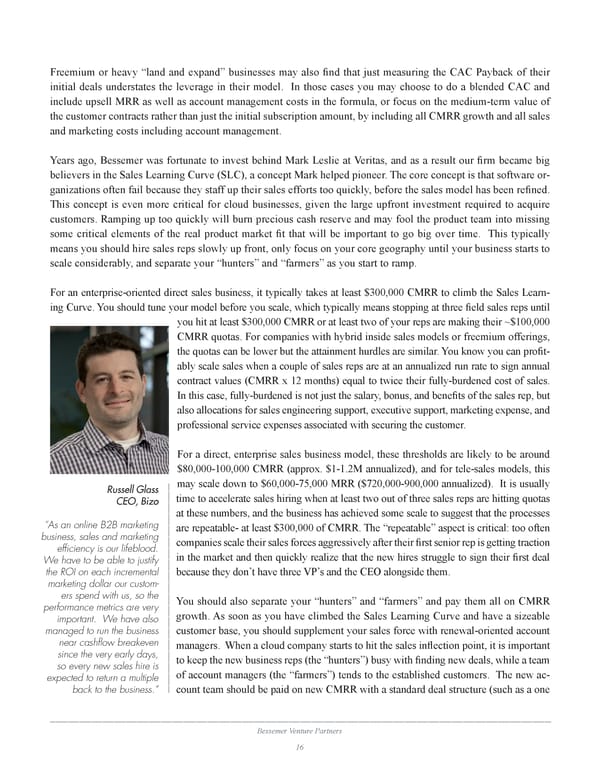Freemium or heavy “land and expand” businesses may also find that just measuring the CAC Payback of their initial deals understates the leverage in their model. In those cases you may choose to do a blended CAC and include upsell MRR as well as account management costs in the formula, or focus on the medium-term value of the customer contracts rather than just the initial subscription amount, by including all CMRR growth and all sales and marketing costs including account management. Years ago, Bessemer was fortunate to invest behind Mark Leslie at Veritas, and as a result our firm became big believers in the Sales Learning Curve (SLC), a concept Mark helped pioneer. The core concept is that software or- ganizations often fail because they staff up their sales efforts too quickly, before the sales model has been refined. This concept is even more critical for cloud businesses, given the large upfront investment required to acquire customers. Ramping up too quickly will burn precious cash reserve and may fool the product team into missing some critical elements of the real product market fit that will be important to go big over time. This typically means you should hire sales reps slowly up front, only focus on your core geography until your business starts to scale considerably, and separate your “hunters” and “farmers” as you start to ramp. For an enterprise-oriented direct sales business, it typically takes at least $300,000 CMRR to climb the Sales Learn- ing Curve. You should tune your model before you scale, which typically means stopping at three field sales reps until you hit at least $300,000 CMRR or at least two of your reps are making their ~$100,000 CMRR quotas. For companies with hybrid inside sales models or freemium offerings, the quotas can be lower but the attainment hurdles are similar. You know you can profit- ably scale sales when a couple of sales reps are at an annualized run rate to sign annual contract values (CMRR x 12 months) equal to twice their fully-burdened cost of sales. In this case, fully-burdened is not just the salary, bonus, and benefits of the sales rep, but also allocations for sales engineering support, executive support, marketing expense, and professional service expenses associated with securing the customer. For a direct, enterprise sales business model, these thresholds are likely to be around $80,000-100,000 CMRR (approx. $1-1.2M annualized), and for tele-sales models, this Russell Glass may scale down to $60,000-75,000 MRR ($720,000-900,000 annualized). It is usually CEO, Bizo time to accelerate sales hiring when at least two out of three sales reps are hitting quotas at these numbers, and the business has achieved some scale to suggest that the processes “As an online B2B marketing are repeatable- at least $300,000 of CMRR. The “repeatable” aspect is critical: too often business, sales and marketing companies scale their sales forces aggressively after their first senior rep is getting traction efficiency is our lifeblood. in the market and then quickly realize that the new hires struggle to sign their first deal We have to be able to justify the ROI on each incremental because they don’t have three VP’s and the CEO alongside them. marketing dollar our custom- ers spend with us, so the You should also separate your “hunters” and “farmers” and pay them all on CMRR performance metrics are very growth. As soon as you have climbed the Sales Learning Curve and have a sizeable important. We have also managed to run the business customer base, you should supplement your sales force with renewal-oriented account near cashflow breakeven managers. When a cloud company starts to hit the sales inflection point, it is important since the very early days, to keep the new business reps (the “hunters”) busy with finding new deals, while a team so every new sales hire is of account managers (the “farmers”) tends to the established customers. The new ac- expected to return a multiple back to the business.” count team should be paid on new CMRR with a standard deal structure (such as a one Bessemer Venture Partners 16
 Bessemer’s Top 10 Laws of Cloud Computing Page 15 Page 17
Bessemer’s Top 10 Laws of Cloud Computing Page 15 Page 17